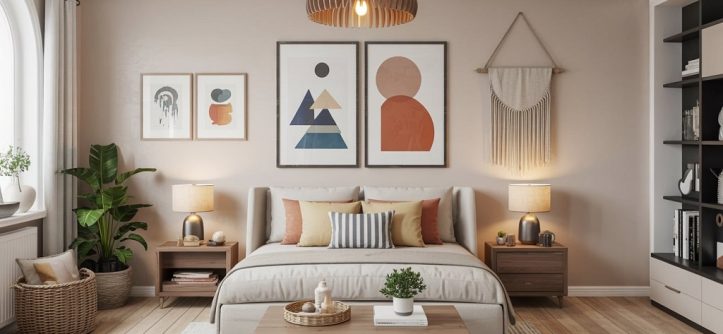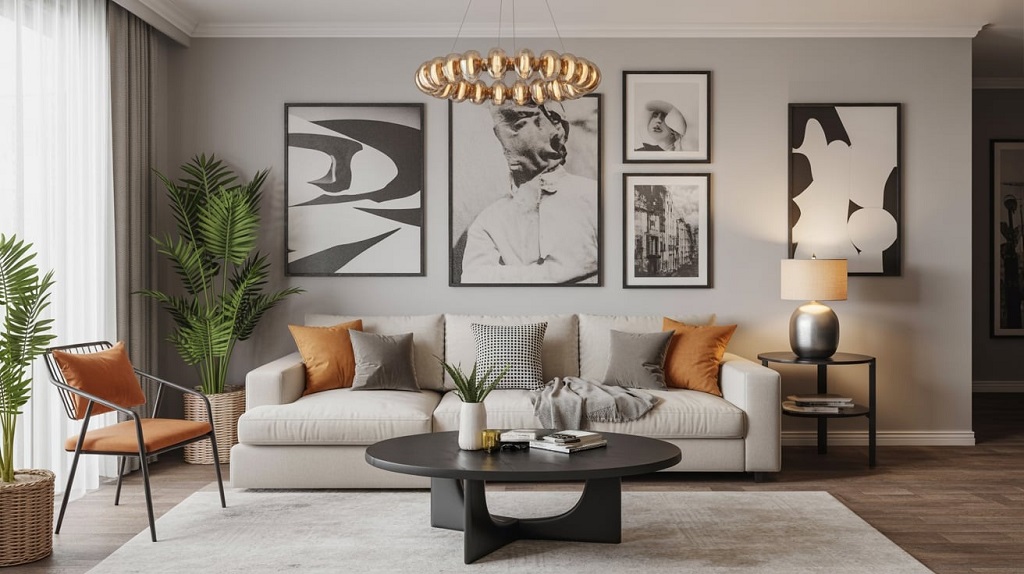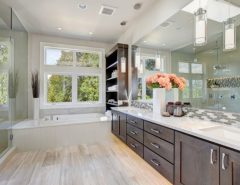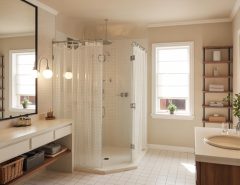Staring at empty walls can feel like looking at a canvas waiting for inspiration to strike. Those blank spaces in your home aren’t just missed opportunities – they’re untapped potential for creating stunning focal points that reflect your personality and transform your living space. Whether you’re a minimalist seeking subtle elegance or a maximalist craving bold statements, the right wall art can breathe life into any room and make your house truly feel like home.
Why Wall Art Matters in Interior Design
Wall art serves as more than mere decoration; it’s the soul of interior design that ties together colors, themes, and emotions within a space. Blank wall solutions go beyond filling empty space – they create visual interest, establish mood, and can even influence how large or cozy a room feels. Professional interior designers understand that walls represent the largest uninterrupted surfaces in most rooms, making them prime real estate for creative expression.
The psychological impact of thoughtfully chosen wall decor cannot be overstated. Art triggers emotional responses, stimulates conversation, and creates lasting impressions on both residents and guests. Studies have shown that well-decorated spaces can improve mood, reduce stress, and enhance overall well-being.
Traditional Wall Art Options That Never Go Out of Style
Paintings and Prints
Classic framed artwork remains the cornerstone of wall decoration for good reason. Original paintings bring unique character and investment value to your space, while high-quality prints offer accessibility to famous works and contemporary designs. When selecting paintings, consider the room’s color palette, lighting conditions, and existing furniture styles.
Canvas art provides texture and depth that flat prints cannot match. The three-dimensional quality of canvas creates subtle shadows and highlights that change throughout the day as natural light shifts. For maximum impact, choose pieces that complement your room’s scale – large canvases work beautifully in spacious areas, while smaller works suit intimate settings.
Photography as Wall Art
Personal photography transforms houses into homes by showcasing meaningful memories and experiences. Photo wall displays can tell your family’s story through carefully curated collections of travel adventures, milestone moments, and everyday beauty. Professional photography, whether landscape, portrait, or abstract, adds sophistication and personal taste to any room.
Consider creating themed photography collections, such as black-and-white family portraits, colorful travel destinations, or nature macro shots. The key is maintaining visual cohesion through consistent framing, matting, or color schemes.
Creative DIY Wall Art Projects
Gallery Wall Arrangements
Gallery walls represent one of the most versatile and budget-friendly approaches to wall decoration. These curated collections allow you to combine different art styles, sizes, and mediums while creating a cohesive visual story. Start by laying out your arrangement on the floor before hanging to ensure proper spacing and balance.
Successful gallery walls follow the “57-inch rule” – hang artwork so the center sits 57 inches from the floor, which aligns with average eye level. Mix frame colors and styles intentionally, perhaps combining sleek black frames with ornate vintage pieces for eclectic charm.
Handmade Art Projects
Creating your own DIY wall decor offers unlimited customization possibilities while staying within budget constraints. Abstract acrylic paintings require minimal artistic experience but deliver maximum visual impact. Experiment with color blocking, texture techniques, or fluid art methods to create pieces that perfectly match your color scheme.
Wall stenciling provides another accessible DIY option for those who prefer structured designs over freeform painting. Geometric patterns, botanical motifs, or inspirational quotes can transform plain walls into statement features.
Innovative Wall Decoration Ideas
Three-Dimensional Wall Elements
Moving beyond flat surfaces, 3D wall art adds sculptural interest and dramatic shadows to your space. Floating shelves arranged in geometric patterns serve dual purposes as storage and artistic elements. Fill them with books, plants, or decorative objects that complement your overall design theme.
Wall sculptures and relief art create fascinating focal points that change appearance throughout the day as lighting shifts. Consider materials like wood, metal, or ceramic that align with your interior design style.
Living Wall Art
Plant wall art brings nature indoors while improving air quality and creating living, breathing decoration. Vertical gardens, hanging planters arranged in artistic patterns, or even a single statement plant in a beautiful planter can serve as organic wall art.
Macramé plant hangers add bohemian flair while showcasing your favorite trailing plants. Air plants mounted on decorative boards create low-maintenance living art that requires minimal care.
Choosing the Right Wall Art for Different Rooms
Living Room Wall Art
The living room serves as your home’s social hub, making it ideal for statement artwork that reflects your personality and interests. Large-scale pieces work well above sofas, while smaller works can complement side tables and accent chairs. Consider the room’s function when selecting art – pieces that encourage conversation work well in social spaces.
Bedroom Wall Decor
Bedroom wall art ideas should promote relaxation and personal comfort. Soft, soothing colors and peaceful subjects help create a restful atmosphere. Consider your bed’s headboard as an opportunity for artistic expression – a large piece or carefully arranged collection can substitute for traditional headboards.
Kitchen and Dining Room Art
These spaces benefit from art that complements their function without overwhelming the practical aspects. Food-themed photography, vintage advertisements, or colorful abstracts can add personality while withstanding the humidity and temperature changes common in cooking areas.
Budget-Friendly Wall Art Solutions
Affordable Art Sources
Budget wall art doesn’t mean compromising on style or impact. Online marketplaces, local art fairs, and student exhibitions offer original pieces at accessible prices. Digital downloads of printable art provide instant access to thousands of designs that you can print at home or local print shops.
Thrift stores and estate sales often yield vintage prints, interesting frames, and unique pieces that add character without breaking the budget. With some creativity and minor restoration, these finds can become stunning focal points.
Repurposing and Upcycling
Transform everyday objects into artistic wall displays through creative repurposing. Vintage plates arranged in geometric patterns, interesting textiles mounted in embroidery hoops, or collections of vintage postcards in matching frames create unique wall art with personal meaning.
Textile wall art using fabric scraps, scarves, or tapestries adds color, texture, and cultural interest to your space. These pieces work especially well in bedrooms and casual living areas.
Professional Tips for Hanging and Arranging Wall Art
Proper Placement and Height
Successful wall art arrangement depends on understanding proper proportions and placement. Artwork should relate to furniture pieces below it – typically extending to about two-thirds of the furniture’s width. Multiple pieces should maintain consistent spacing, usually 2-3 inches apart for related works.
Consider the room’s architecture when planning placement. High ceilings can accommodate taller pieces or vertical arrangements, while standard ceiling heights benefit from horizontal orientations that emphasize width.
Lighting Considerations
Proper lighting transforms good wall art into spectacular focal points. Picture lights, track lighting, or strategically placed accent lamps can highlight artwork while creating ambient lighting for the entire room. Avoid placing art in direct sunlight, which can cause fading and damage over time.
Read More Also: Crafting Your Dream Space: Expert Bathroom Remodeling
Maintaining and Caring for Your Wall Art
Regular maintenance preserves your wall art investment and keeps displays looking fresh. Dust frames and glass regularly with microfiber cloths, and check hanging hardware periodically for signs of wear. Rotate pieces occasionally to prevent sun damage and keep your decor feeling current.
For valuable pieces, consider professional cleaning and conservation services. Proper climate control and UV-protective glass can extend the life of important artworks significantly.
Read More Also: How to Spot Problems and Find Reliable Fixes Today
Frequently Asked Questions
What size wall art should I choose for my space?
The ideal size depends on your wall dimensions and surrounding furniture. As a general rule, artwork should cover 60-75% of the wall space above furniture pieces. For blank walls without furniture below, consider the wall’s total size – larger walls can accommodate substantial pieces or multiple works, while smaller walls benefit from appropriately scaled single pieces.
How do I create a cohesive look with different art styles?
Maintain visual cohesion through consistent elements like color palette, framing style, or subject matter. Even eclectic collections can work together when unified by common threads. Consider limiting your color scheme to 2-3 dominant colors, or use matching frames to tie diverse pieces together.
What’s the best way to hang heavy artwork safely?
Heavy pieces require appropriate wall anchors and hardware rated for the artwork’s weight. Use wall studs when possible, or invest in heavy-duty hollow wall anchors for drywall installations. When in doubt, consult a professional – proper installation protects both your artwork and your walls.
How often should I change my wall art?
There’s no set timeline for rotating wall art, but seasonal changes or major life events provide natural opportunities for updates. Some people enjoy quarterly rotations to keep their space feeling fresh, while others prefer stable displays that evolve gradually over time.
Can I mix different frame styles and colors?
Absolutely! Mixed framing can add visual interest and personality to your displays. The key is intentional variation rather than accidental mismatch. Try combining different frame styles within the same color family, or mix frame colors while maintaining consistent styles.
Transform Your Space Today
Your walls are waiting for transformation, and the possibilities are as limitless as your imagination. Whether you choose elegant paintings, creative DIY projects, or innovative three-dimensional elements, the right wall art will turn your blank walls into personal galleries that reflect your unique style and enhance your daily living experience.
Ready to start your wall art journey? Begin by assessing your space, identifying your style preferences, and setting a realistic budget. Remember that great wall displays often evolve over time, so start with pieces you love and build your collection gradually. Your walls will thank you, and your home will never feel empty again.
Take action today: Choose one blank wall in your home and commit to transforming it this month. Whether you start with a single meaningful piece or plan an elaborate gallery wall, your first step toward beautiful wall art begins now.






Leave a Reply